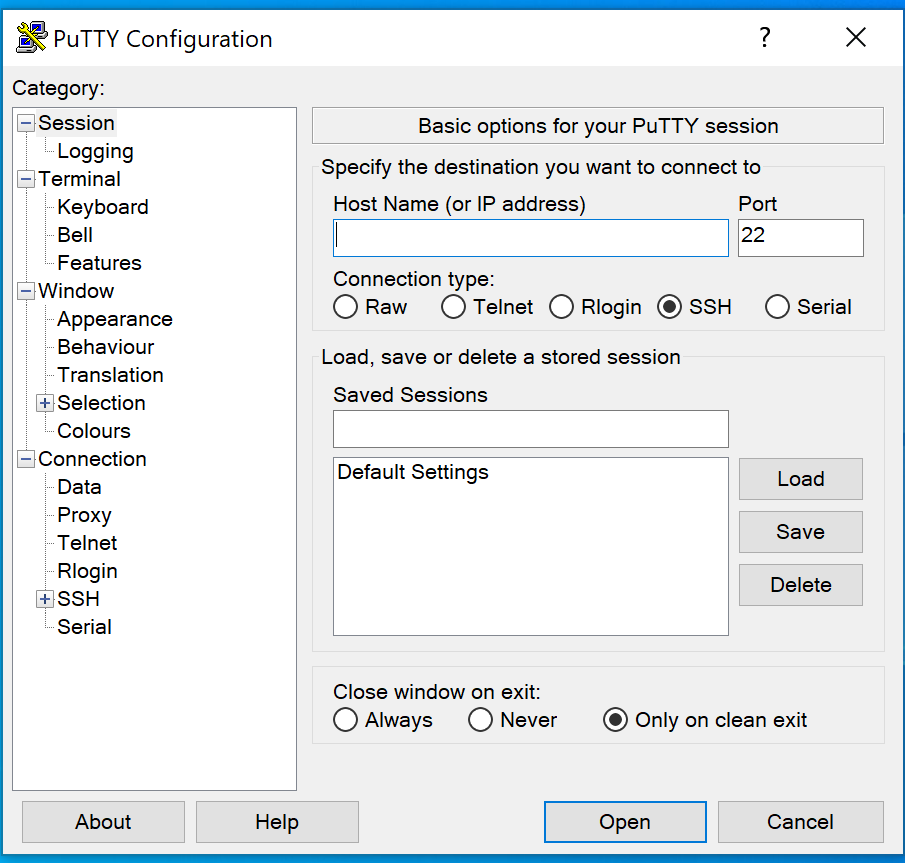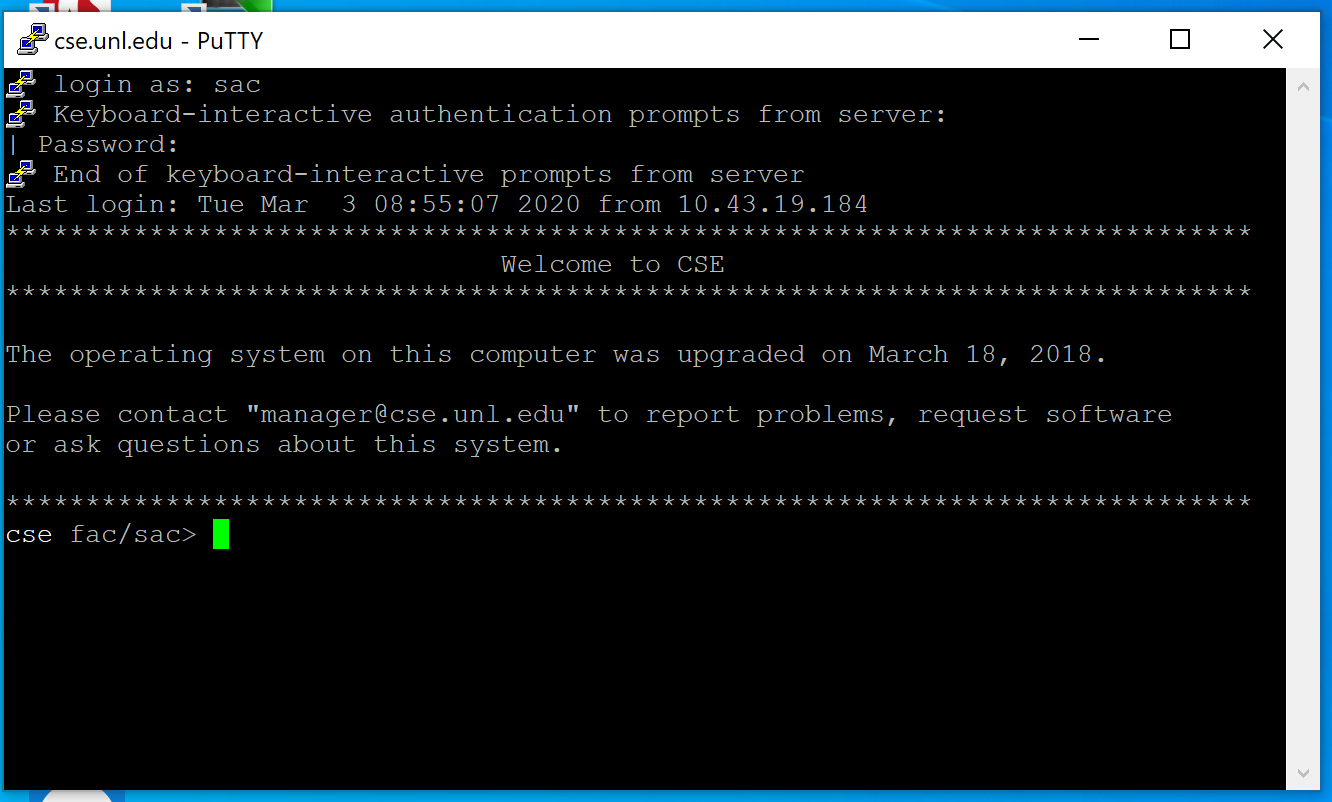School of Computing Resources
Students enrolled in courses (CSCE, SOFT, and RAIK) taught by faculty of the School of Computing, (CSCE, SOFT or RAIK) automatically have accounts on the nuros.unl.edu, (formerly known as cse-linux-01.unl.edu) server. To access this server, the easiest way is to open a terminal window in MacOS, or the Command Prompt or PowerShell in Windows 10 or 11, and use the ssh command:
ssh jdoe2@nuros.unl.edu
Substituting your MyRed login for jdoe2 in the command and entering your MyRed password when prompted. If you have never logged into the nuros.unl.edu server, a new home directory will be created for you. The nuros.unl.edu server offers a variety of software development tools, frameworks and services including MySQL server accounts. You can also access nuros.unl.edu using the NoMachine application if a GUI interface to the server is needed.
Some students may need a School of Computing (SoC) account (refered to as your CSE account) if they are doing research with faculty or accessing legacy software that is only available on the legacy CSE systems. This CSE account is used to access legacy SoC servers, websites, and network shares. A CSE account is separate from a My.UNL account (e.g. jdoe2) which is used to access UNL services like Canvas, Box, and Microsoft 365, and a TrueYou account (e.g. 12345678) which is used to access NU (system-wide) services like MyRED and Firefly. Usernames for CSE accounts do not contain any numbers, and the password for your CSE account is not synchronized to your My.UNL or TrueYou account password. If you have been told by an instructor or faculty member that you need to access the legacy systems using a CSE account, you can create one online at https://cse.unl.edu/claim by entering your full @huskers.unl.edu email address. After submitting your Huskers email address, you’ll receive a confirmation email at that address; click the link in the email to verify your identity and set up your new CSE account. This process will prompt you to choose your own password for your account, complete the consent form to agree to the university’s computer use guidelines, and then provide you with the username (or LoginID) for your CSE account. Make note of the username/LoginID for your CSE account, as it will be different than the My.UNL account username you use to access Canvas and other UNL services.
If you already have a CSE account (e.g. from a previous CSCE/SOFT/RAIK course) but don’t remember your username, go to https://cse.unl.edu/lost_login. If you have forgotten your password, go to https://cse.unl.edu/reset_password. Both links will prompt you to enter your full @huskers.unl.edu email address to have your CSE login sent to you or request your password be reset.
Below is a quick start guide on resources available for students enrolled in SoC courses.
Printing: A printer is available for all SoC students in Avery 15. To print to a printer, then follow the appropriate instructions below:
- Windows: https://computing.unl.edu/faq/winprt
- MacOS: https://computing.unl.edu/faq/macprt
- Linux: https://computing.unl.edu/faq/lnxprt
Printer access is dependent on having the correct settings for your connection to the EDUROAM network on campus.
Storage: While OneDrive can be accessed through a web browser on our lab computers, when developing code on lab computers, we recommend using a thumb drive or mapping a network share. One is made available to School of Computing students (referred to as your home directory) You will first need to claim your CSE account by visiting the link at the top of this document, then follow the instructions below.
Mapping your home directory to lab computers: https://computing.unl.edu/faq/labdrv
Access your CSE home directory from a personal device:
Accessing OneDrive on lab computers: https://computing.unl.edu/faq/onedrive
Handin: If your course requires you to submit code or use the web grader you might be asked to use handin. The handin application: https://cse.unl.edu/handin uses your MyRed login and password to submit assignments.
Remote Linux Access: A lot of classes in the School of Computing will require you to access our remote Linux server using Secure Shell (SSH). The links below show the step-by-step process of using SSH to connect to the servers.
- Windows: https://computing.unl.edu/faq/winssh
- MacOS: https://computing.unl.edu/faq/macssh
- Linux: https://computing.unl.edu/faq/lnxssh
Helpful links and getting additional support:
- CSE Account Management Portal: http://cse.unl.edu/account
- FAQs: https://computing.unl.edu/faq
- Email Support: support@cse.unl.edu
- CSE System Administration: Room 27 Avery Hall, 402-472-7757
Connecting to cse.unl.edu and other Unix servers with SSH from Windows
You can connect to the School of Computing (SoC) CSE server (cse.unl.edu) and other UNIX servers in the department using the PuTTY SSH client.
PuTTY can be downloaded from the this web site. After you have downloaded and installed PuTTY, you can use it to connect to cse.unl.edu.
Double click the PuTTY icon on the desktop or enter "putty" in the search bar to start PuTTY:
Enter "cse.unl.edu" in the Host Name (or IP address) field and hit enter.
The first time you connect to a remote host, you will receive a message stating: "The server's host key is not cached int the registry. You have to guarantee that the server is the computer you think it is." You should click "Yes" here.
Next, you will be prompted to enter a user name and password. This is your SoC user name and password; this example uses "sac" as the user name and cse.unl.edu as the login server:
If you are prompted for a Verification code: after entering your password, examine the user name you supplied. User names that end digits (1 through 9) are not SoC user names that can be used to login to CSE and other SoC servers.
How do I print from a Windows PC on campus?
New! Printing has changed, please use the updated instructions below.
To print documents from computer lab Windows PCs or your personal Windows PC laptop you will need to install a network printer.
Launch File Explorer. Go to search in task bar and search "File Explorer" or select the File Explorer from the Windows System menu.

In the File Explorer address bar, type in \\its-acadprt-unl.unl.edu as shown.

When you are asked to enter your network credentials, you will need to login with your MyUNL credentials. Your user name must be provided as MyUNL_ID@unl.edu where MyUNL_ID is your UNL login ID.
The Remember my credentials box must be checked for printing to work properly.
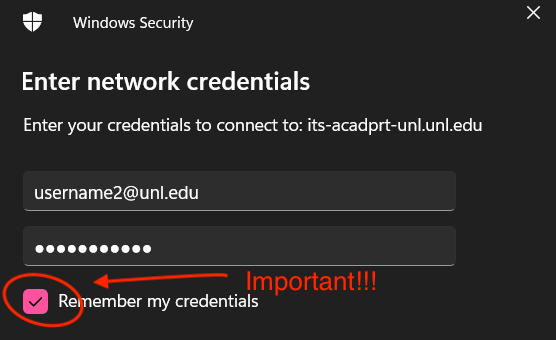
Once successfully authenticated, you will be presented with a list of printers. Printers are generally named by the building and room they are in. Now click on the printer you want to connect to and select connect.

NOTE: Only the below printers are available for students:
- SoC_Avery15
- SoC_Avery12
- SoC_Avery12color
Alll other SoC printer have access controls for specific users in those areas.
Common Issues
On your personal device, make sure you are connected to eduroam and eduroam must be configured as a private network.
Norton Anti-virus and certain other anti-virus vendors will prevent outgoing SMB connections. Please use the UNL provided anti-virus software CortexXDR offered thru UNL ITS.
If Windows does not prompt you for credentials, or if you cannot browse the \\its-acadprt-unl.unl.edu network, the problem lies in the Windows configuration. Verify eduroam is a private (local) network, verify your system is fully updated to the latest Windows updates and then verify that the SMB client is enabled. Here are some Instructions for how to determine if your SMB Client is enabled, and how to enable it.
There are many caveats to windows printing. If you need help please email support@cse.unl.edu. You may be asked to bring your personal device (laptop) in to the support office if your problem cannot be resolved via email.
Accessing and Using Microsoft One Drive
Microsoft OneDrive Storage
Microsoft OneDrive is free cloud storage for programs and data. Students, faculty and staff are eligible for this service.
OneDrive storage offers the advantages of cloud-accessible content, so your files are always available where you have cloud access. You can share folders (directories) on OneDrive with members of your project teams, thus enabling a simple shared project document space.
- All UNL users will begin with 5 Terabytes of storage.
- UNL users can access and use Microsoft OneDrive within a browser (Edge, Chrome, Firefox, etc.) from the lab computer systems.
- On your personal devices you can access the browser-accessible version or download the OneDrive client application. Users who have installed Office365 provided by UNL have the OneDrive client installed as part of the Office365 suite.
Access Microsoft OneDrive in Computer Labs
To access Microsoft OneDrive from a lab computer, open a web browser (Edge, Chrome, Firefox) and enter the URL:
https://portal.office.com
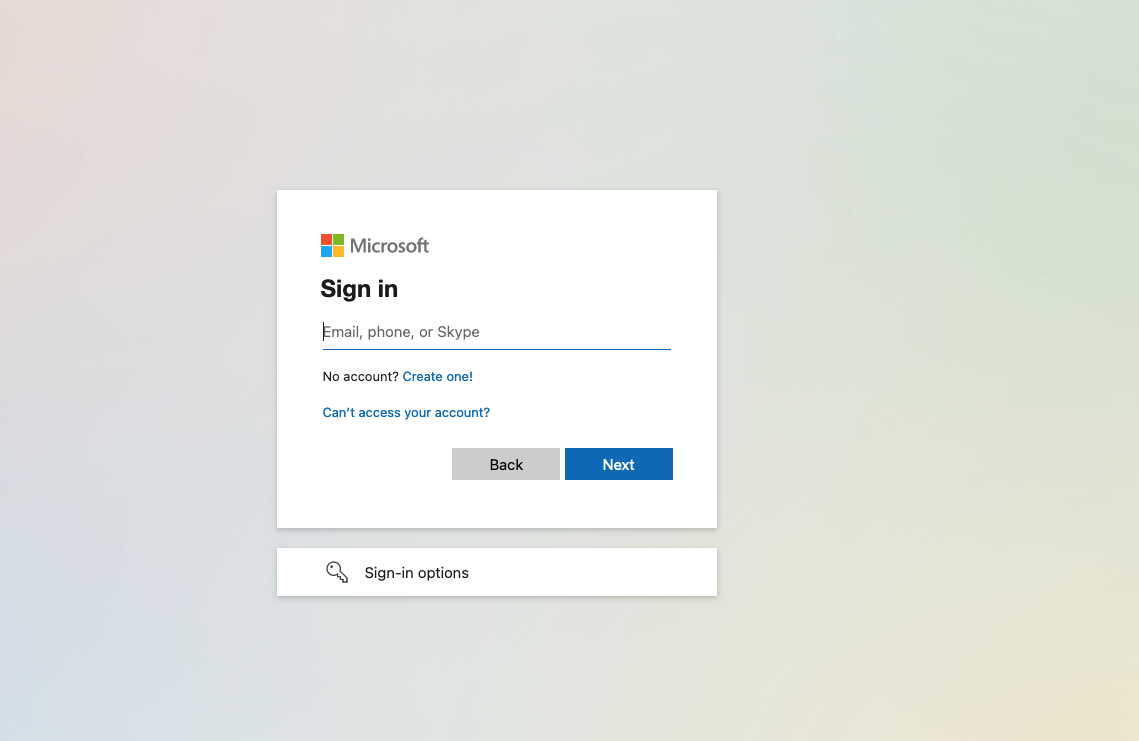
Enter your UNL credentials, e.g. jsmith2@unl.edu, and press Next
You will be redirected to the UNL two-factor login page:

After completing two-factor authentication you will be redirected to the main Office365 page. From there you will need to select the OneDrive application from the menu:
Select the Office applications menu via the top-left corner of the page:
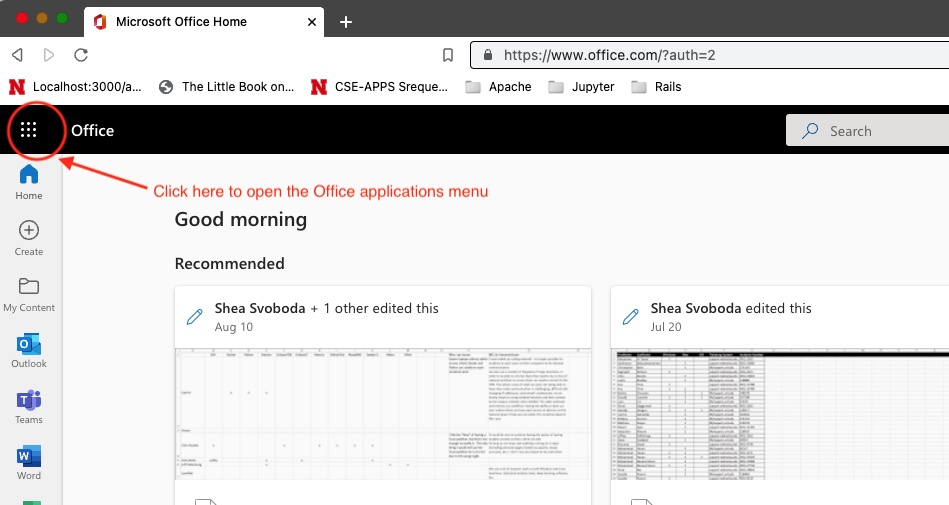
and select the OneDrive application:

The OneDrive application will open in a new tab or window depending on your browser settings.
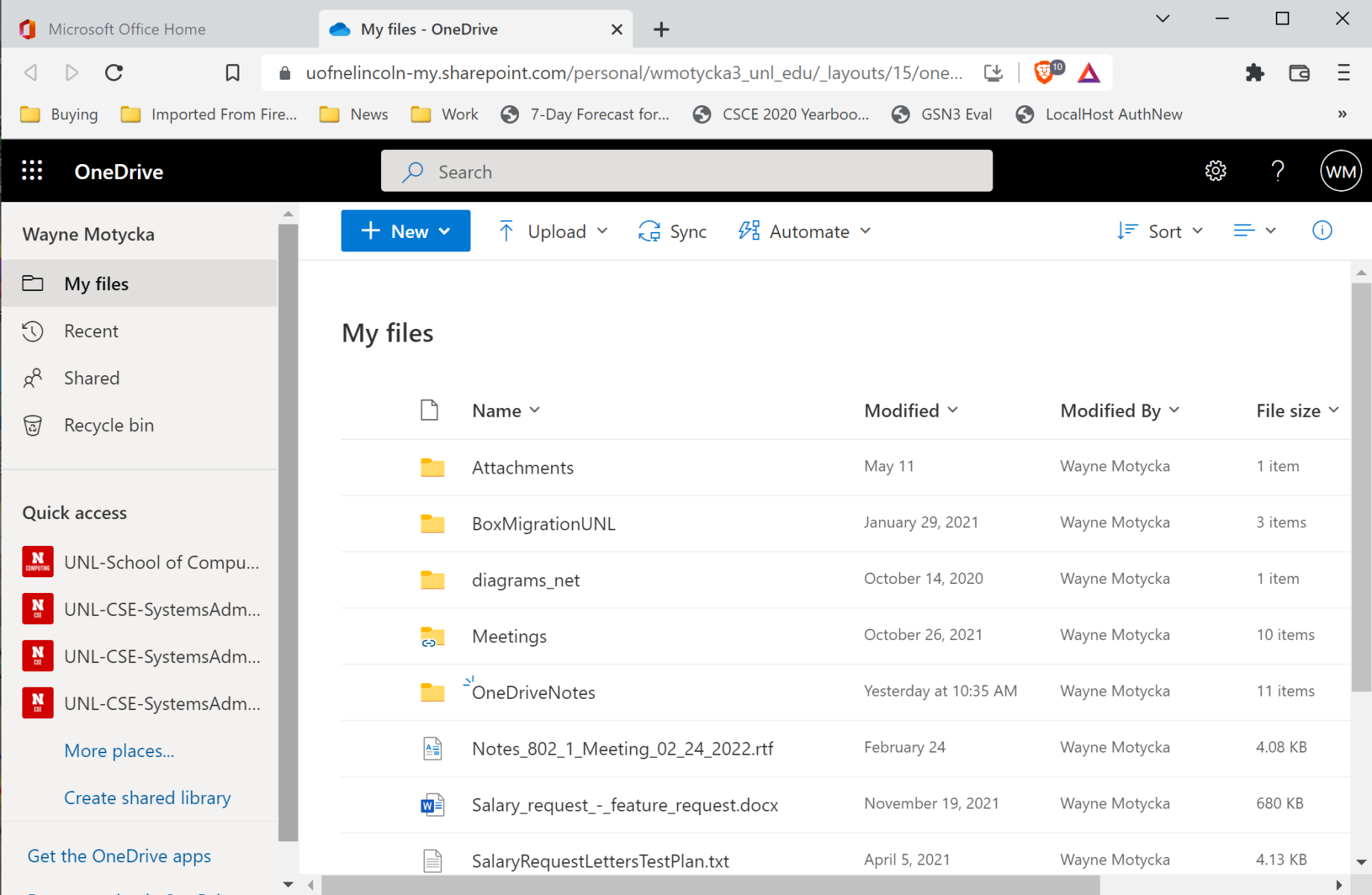
File Transfer to OneDrive
Transferring your files up or down from OneDrive is performed using the Windows File Explorer application. To upload, select the file you want to upload using the File Explorer, and drag-and-drop it onto your OneDrive browser window.
To download, select the file you want within the OneDrive browser window, and choose the Download option from the menu:

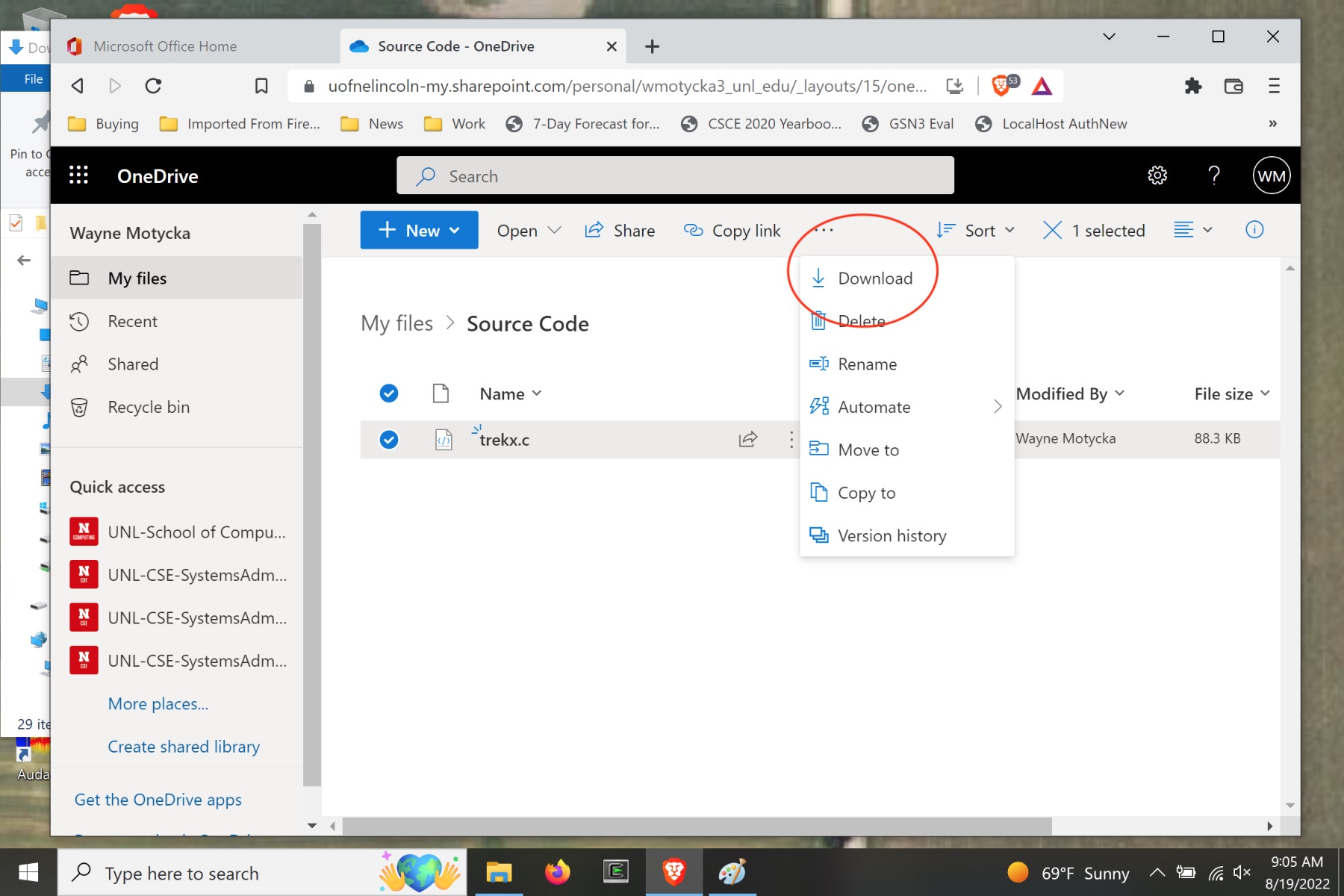
The Download option presents a Save As window allowing you to save the downloaded source file anywhere on the Windows system, including other network drives.
OneDrive with MacOS
Using OneDrive on a personal Mac OS laptop can be done using the web interface or the Office365 OneDrive client application. The web browser access outlined above also works for Mac OS and the ability to drag-and-drop files from the Finder application offers easy upload capability while downloading mechanisms are identical. The OneDrive client application integrates the OneDrive files into the Finder:
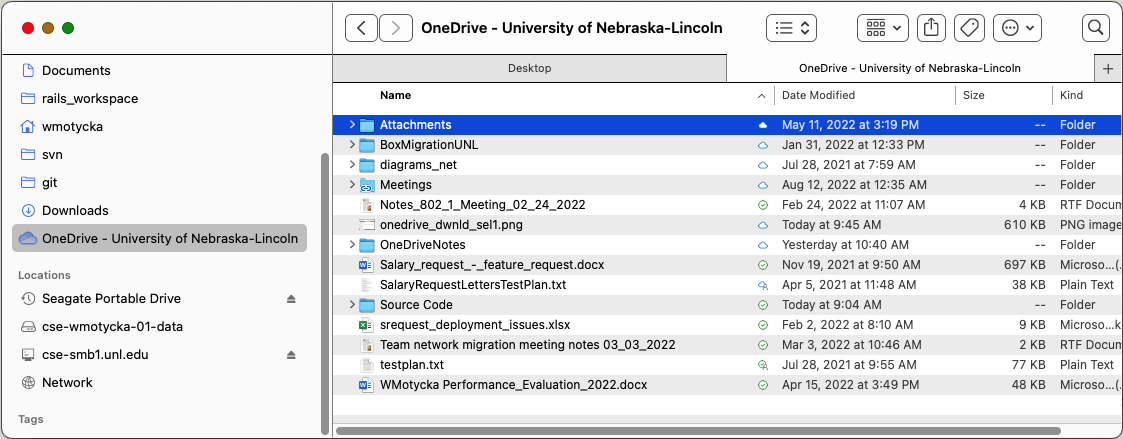
How do I access my CSE home directory from a Windows PC on campus?
If you are working on campus from a computer lab or on your personal laptop, you might wish to map your home directory from the school server directly onto your laptop, so as to not have to transfer files up and down.
The instructions given are for Windows 10:
- Launch File Explorer, there are many way to do this: From the start menu, select the Documents item to open the "File Explorer".
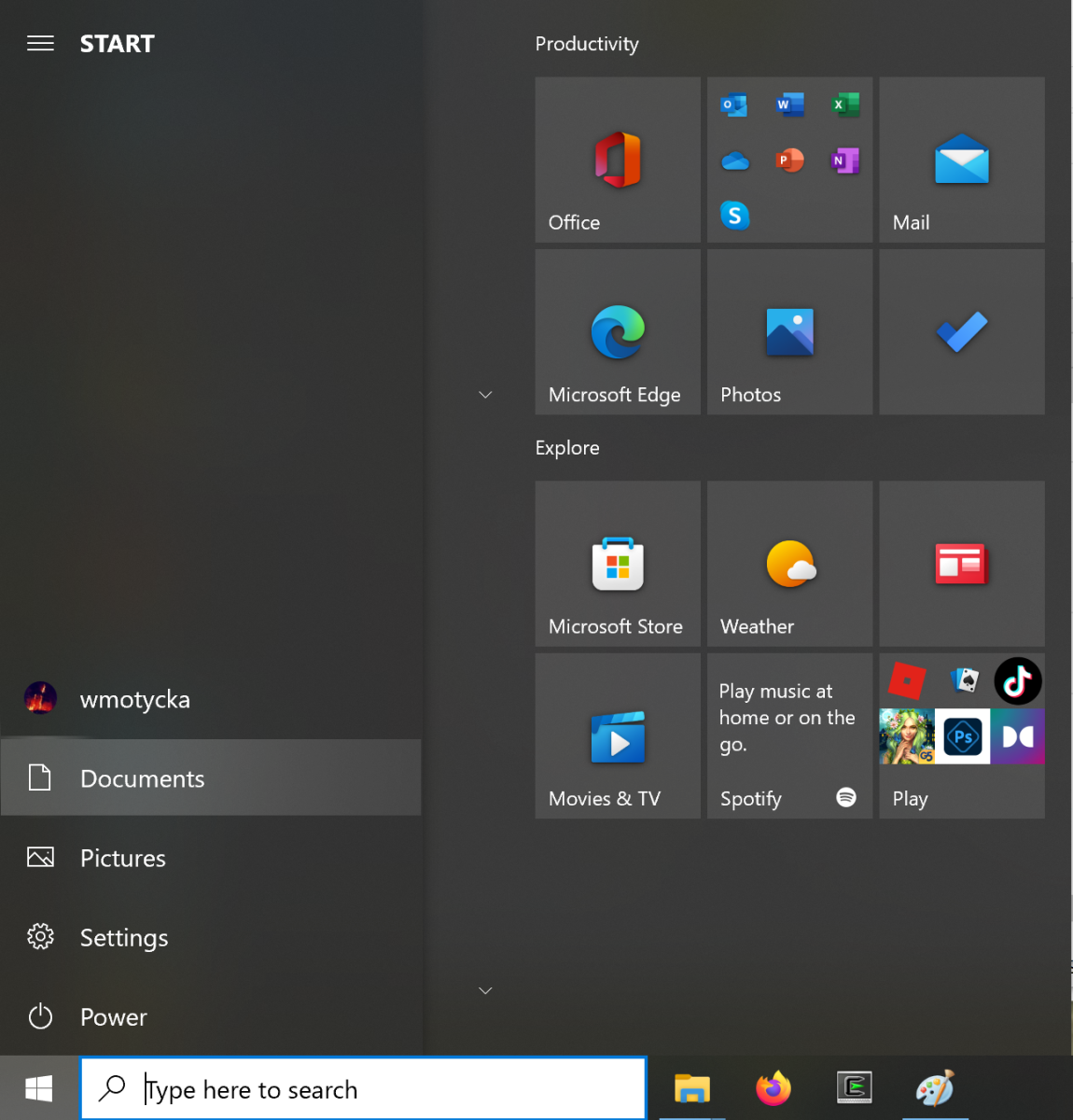
Or you can select the "File Explorer" from the Windows System menu.

If you have a "My Computer" or "My PC" icon on the desktop, you can double click on the icon to launch File Explorer. - In the File Explorer window, click on the Computer tab on the top of the window to display a ribbon, then click the Map network drive icon if shown:
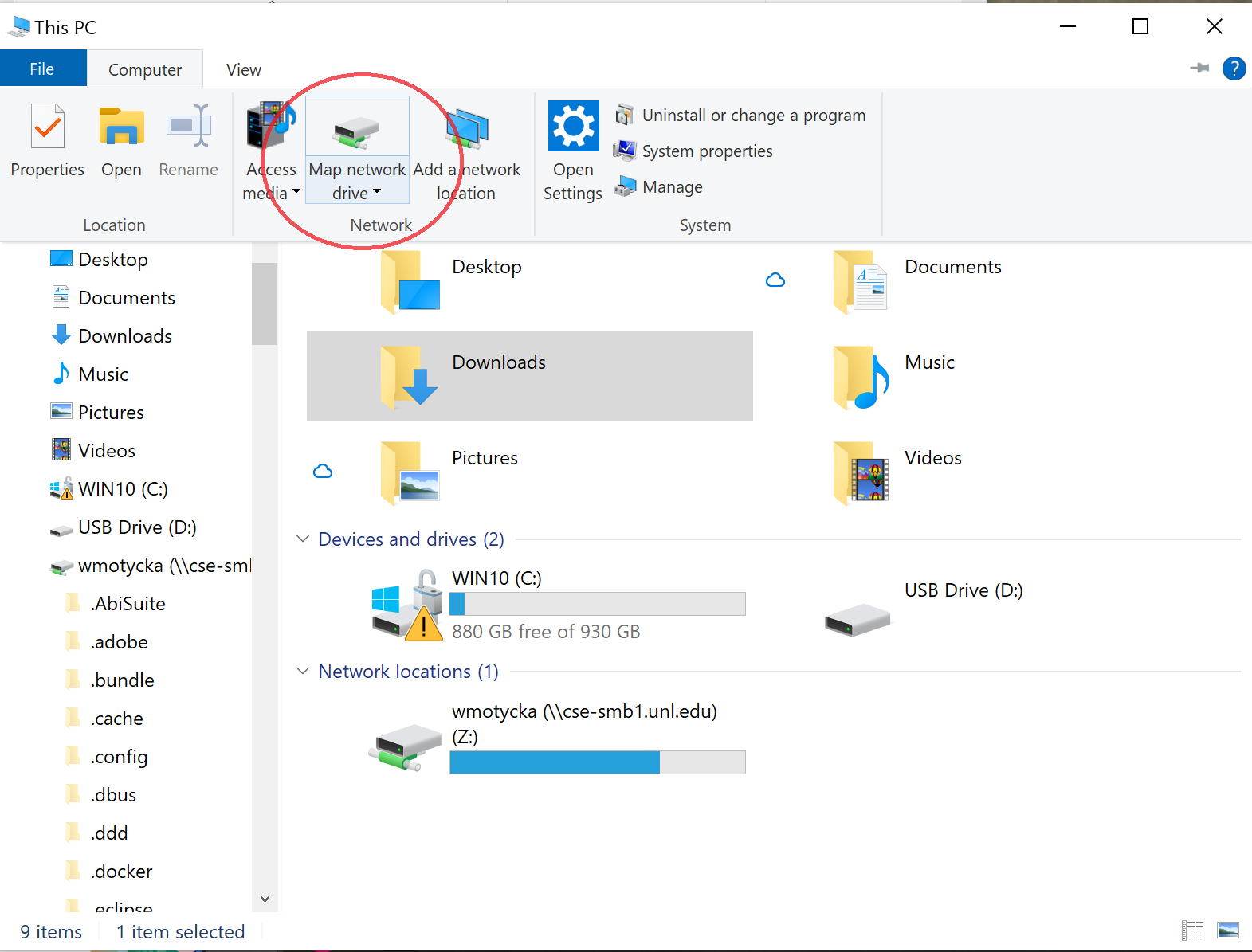
or right-click on "My PC" to show the 'map network drive' option.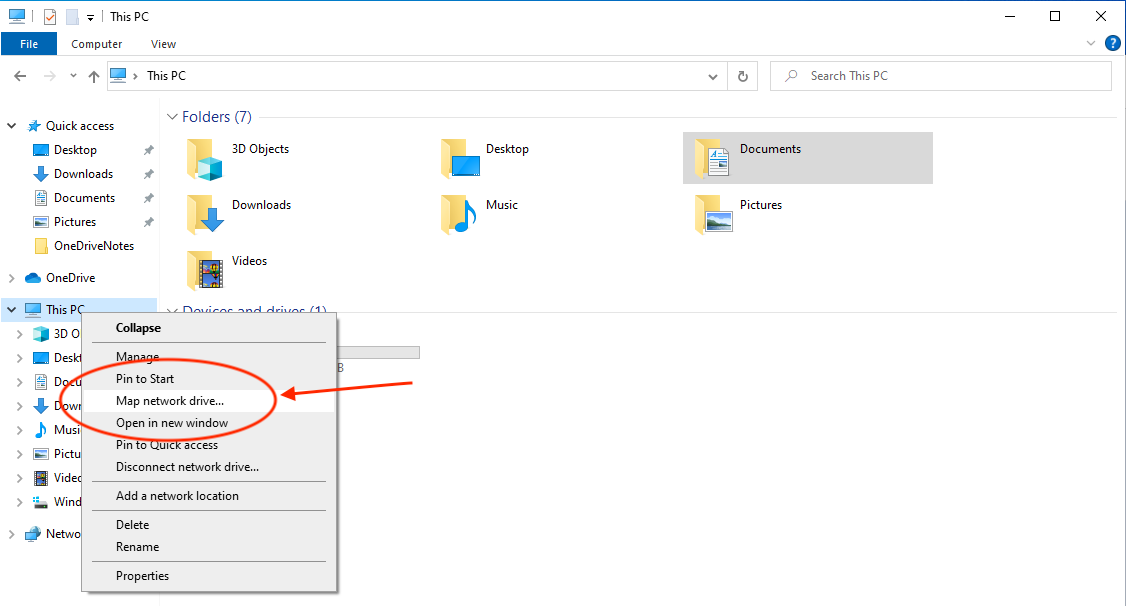
This will open a "Map Network Drive" dialog.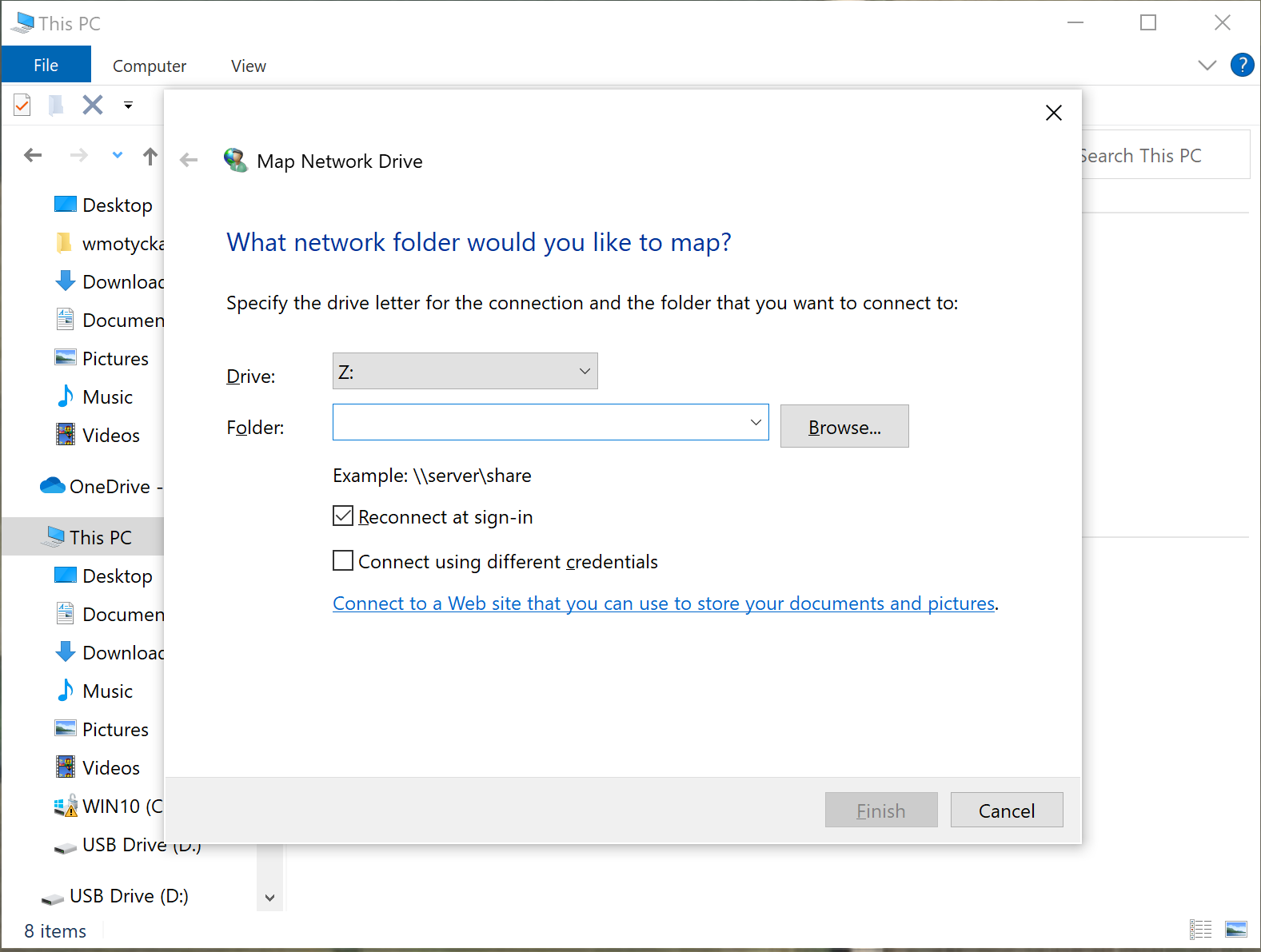
- In the dialog, type in "\\cse-smb1.unl.edu\login_id" without the quotes and where login_id would be your School of Computing CSE login ID. For example if your CSE login was csmith, your folder path would be: \\cse-smb1.unl.edu\csmith
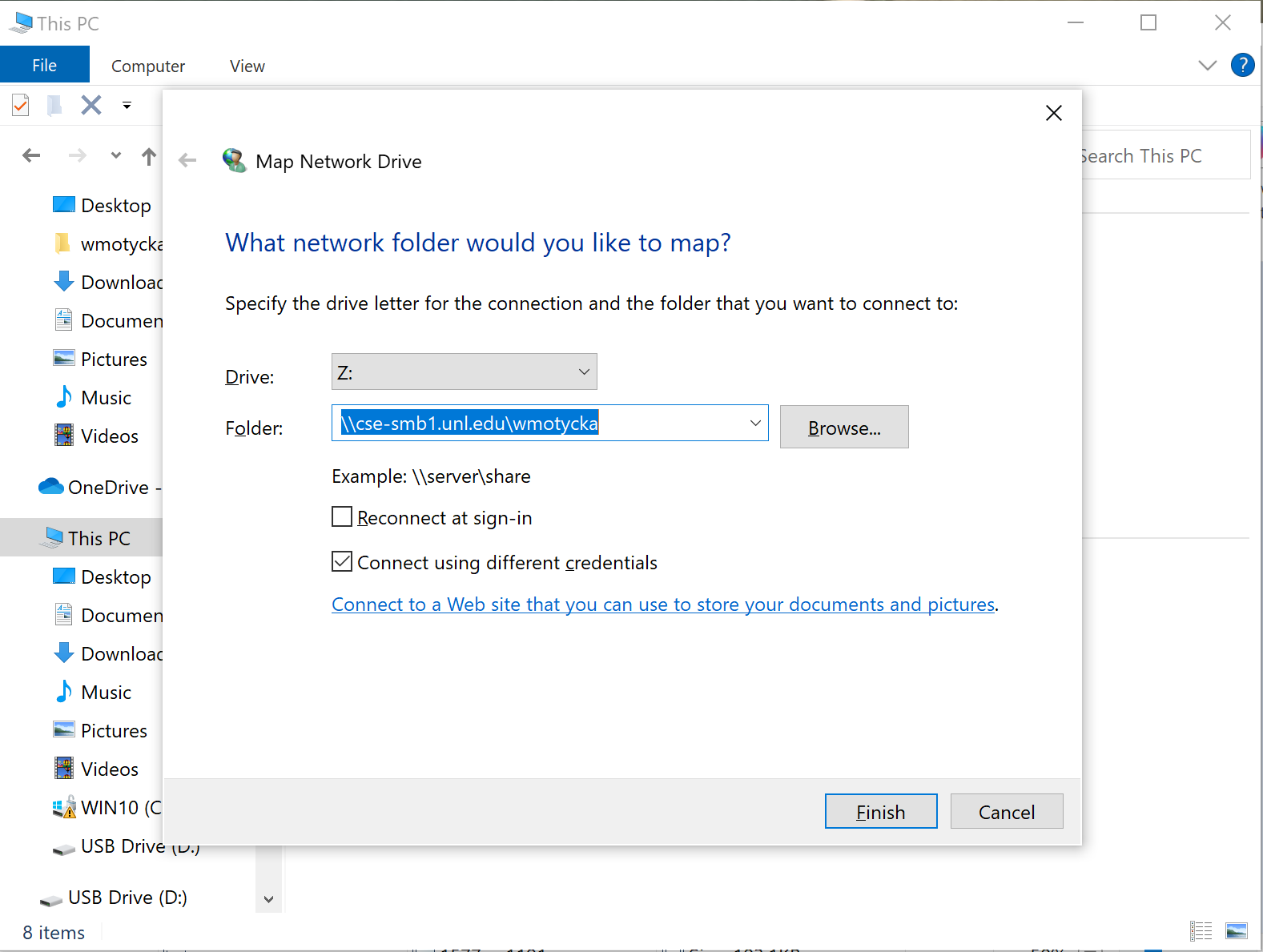
- Check on the "Connect using different credentials" checkbox, uncheck "re-connect at sign-in" and click on the "Finish" button.
- When you are asked to enter your network credentials, you will need to login with your SoC credentials. Your user name must be provided as "CS.UNL.EDU\username". As in the example above, if your CSE username (login) was csmith, the user name value would be: CS.UNL.EDU\csmith

- Provide your CSE password and Click "OK". You should see your home directory from the departmental server mapped as a drive in the File Explorer window.
If you are not offered the option to enter credentials or Windows returns an error indicating it cannot communicate or find the cse-smb1.unl.edu server, ensure you are connect to the eduroam network, and the eduroam network is private network. You can verify that you have the required Windows client service enabled using these instructions on Windows SAMBA settings.
